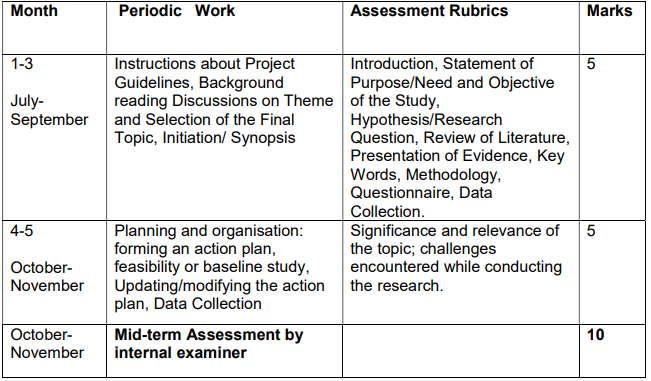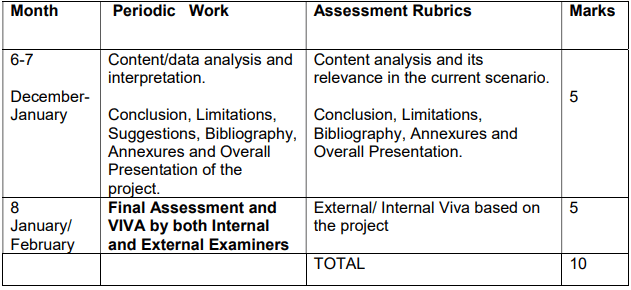NCERT CBSE Class 12 Economics Syllabus comprises of the following chapters for revised CBSE Syllabus 2021-22 (Class 12 Term wise Curriculum)
Class 12 Economics Syllabus Term-wise 2021-22
Term 1 – MCQ Bases Question Paper
Theory: 40 Marks
Time: 90 minutes
| Chapters | Marks | Periods |
| Part A: Introductory Macroeconomics | ||
| ▪ Money and Banking | 6 | 8 |
| ▪ Government Budget and the Economy | 6 | 15 |
| ▪ Balance of Payments | 6 | 7 |
| Sub Total | 18 | 30 |
| Part B: Indian Economic Development | ||
| ▪ Development Experience (1947-90) and Economic Reforms since 1991:
● Indian Economy on the eve of Independence ● Liberalisation, Privatisation and Globalisation : An Appraisal |
12 | 28 |
| ▪ Current challenges facing Indian Economy
● Poverty |
10 | 17 |
| Sub Total | 22 | 45 |
| Total | 40 | 75 |
| Project Work (Part 1): 10 Marks |
Students would prepare only ONE project in the entire academic session, which is divided into 2 terms i.e. Term I and Term II.
Class 12 Economics Syllabus Term 1
Part A: Introductory Macroeconomics
Unit 2: Money and Banking – 8 Periods
Money – meaning and supply of money – Currency held by the public and net demand deposits held by commercial banks.
Money creation by the commercial banking system.
Central bank and its functions (example of the Reserve Bank of India): Bank of issue, Govt. Bank, Banker’s Bank, Control of Credit
Unit 4: Government Budget and the Economy – 15 Periods
Government budget – meaning, objectives and components.
Classification of receipts – revenue receipts and capital receipts; classification of expenditure – revenue expenditure and capital expenditure.
Measures of government deficit – revenue deficit, fiscal deficit, primary deficit their meaning
Unit 5: Balance of Payments – 7 Periods
Balance of payments account – meaning and components;
Foreign exchange rate – meaning of fixed and flexible rates and managed floating.
Part B: Indian Economic Development
Unit 6: Development Experience (1947-90) and Economic Reforms since 1991 28 Periods
A brief introduction of the state of Indian economy on the eve of independence. Indian economic system and common goals of Five Year Plans. Main features, problems and policies of agriculture (institutional aspects and new agricultural strategy), industry (IPR 1956; SSI – role & importance) and foreign trade.
Economic Reforms since 1991:
Features and appraisals of liberalisation, globalisation and privatisation (LPG policy); Concepts of demonetization and GST
Unit 7: Current challenges facing Indian Economy – 17 Periods
Poverty– absolute and relative; Main programmes for poverty alleviation: A critical assessment;
Human Capital Formation: How people become resource; Role of human capital in economic development;
Rural development: Key issues – credit and marketing – role of cooperatives; agricultural diversification;
Class 12 Economics Syllabus Term 2 Subjective Question Paper
Theory: 40 Marks
Time: 2 Hours
| Chapters | Marks | Periods |
| Part A: Introductory Macroeconomics | ||
| ▪ National Income and Related Aggregates | 10 | 23 |
| ▪ Determination of Income and Employment | 12 | 22 |
| Sub Total | 22 | 45 |
| Part B: Indian Economic Development | ||
| ▪ Current challenges facing Indian Economy
● Employment ● Infrastructure ● Sustainable Economic Development |
12 | 18 |
| ▪ Development Experience of India – A Comparison with Neighbours-
● Comparative Development Experience of India and its Neighbours |
06 | 12 |
| Sub Total | 18 | 30 |
| Total | 40 | 75 |
| Project Work: 10 Marks |
Class 12 Economics Syllabus Term – II
Part A: Introductory Macroeconomics
Unit 1: National Income and Related Aggregates – 23 Periods
What is Macroeconomics?
Basic concepts in macroeconomics: consumption goods, capital goods, final goods, intermediate goods; stocks and flows; gross investment and depreciation.
Circular flow of income (two sector model); Methods of calculating National Income – Value Added or Product method, Expenditure method, Income method.
Aggregates related to National Income:
Gross National Product (GNP), Net National Product (NNP), Gross Domestic Product (GDP) and Net Domestic Product (NDP) – at market price, at factor cost; Real and Nominal GDP.
GDP and Welfare
Unit 3: Determination of Income and Employment – 22 Periods
Aggregate demand and its components.
Propensity to consume and propensity to save (average and marginal).
Short-run equilibrium output; investment multiplier and its mechanism.
Meaning of full employment and involuntary unemployment.
Problems of excess demand and deficient demand; measures to correct them – changes in government spending, taxes and money supply through Bank Rate, CRR, SLR, Repo Rate and Reverse Repo Rate, Open Market Operations, Margin requirement.
Part B: Indian Economic Development
Unit 7: Current challenges facing Indian Economy – 18 Periods
Employment: Growth and changes in work force participation rate in formal and informal sectors; problems and policies
Infrastructure: Meaning and Types: Case Studies: Health: Problems and Policies- A critical assessment;
Sustainable Economic Development: Meaning, Effects of Economic Development on Resources and Environment, including global warming
Unit 8: Development Experience of India: 12 Periods
A comparison with neighbours
India and Pakistan
India and China
Issues: economic growth, population, sectoral development and other Human Development
Indicators
Part C: Project in Economics 15 Periods
Prescribed Books:
1. Statistics for Economics, NCERT
2. Indian Economic Development, NCERT
3. Introductory Microeconomics, NCERT
4. Macroeconomics, NCERT
5. Supplementary Reading Material in Economics, CBSE
Guidelines for Project Work: 20 Marks
(ECONOMICS)
Only ONE Project is to be done throughout the session.
1. The objectives of the project work:
Objectives of project work are to enable learners to:
- Probe deeper into personal enquiry, initiate action and reflect on skills, knowledge and views etc. acquired during the course of class XI-XII.
- analyse and evaluate real world scenarios using theoretical constructs and arguments.
- demonstrate the application of critical and creative thinking skills and abilities to produce an independent and extended piece of work
- follow up aspects in which learners have interest
- develop the communication skills to argue logically
2. Role of the teacher:
The teacher plays a critical role in developing thinking skills of the learners. A teacher should:
- help each learner select the topic based on recently published extracts from the news media, government policies, RBI bulletin, NITI Aayog reports, IMF/World Bank reports etc., after detailed discussions and deliberations of the topic
- play the role of a facilitator and supervisor to monitor the project work of the learner through periodic discussions
- guide the research work in terms of sources for the relevant data
- educate learner about plagiarism and the importance of quoting the source of the information to ensure authenticity of research work
- prepare the learner for the presentation of the project work
- arrange a presentation of the project file
3. Steps involved in the conduct of the project:
Students may work upon the following lines as a suggested flow chart:
Choose a title/topic
↓
Collection of the research material/data
↓
Organization of material/data
↓
Present material/data
↓
Analysing the material/data for conclusion
↓
Draw the relevant conclusion
↓
Presentation of the Project Work
- The project work can be in the form of Power Point Presentation/Exhibition/Skit/albums/files/song and dance or culture show /story telling/debate/panel discussion, paper presentation and so on. Any of these activities which are suitable to visually impaired/differently-abled candidates can be performed as per the choice of the student.
4. Expected Checklist for the Project Work:
- Introduction of topic/title
- Identifying the causes, events, consequences and/or remedies
- Various stakeholders and effect on each of them
- Advantages and disadvantages of situations or issues identified
- Short-term and long-term implications of strategies suggested in the course of research
- Validity, reliability, appropriateness and relevance of data used for research work and for presentation in the project file
- Presentation and writing that is succinct and coherent in project file
- Citation of the materials referred to, in the file in footnotes, resources section, bibliography etc.
5. Term-Wise Assessment of Project Work:
- Project Work has broadly the following phases: Synopsis/ Initiation, Data Collection, Data Analysis and Interpretation, Conclusion.
- The aspects of the project work to be covered by students can be assessed during the two terms.
- 20 marks assigned for Project Work can be divided in to two terms in the following manner:
TERM-I PROJECT WORK (Part 1): 10 Marks
The teacher will assess the progress of the project work in the term I in the following manner:

TERM- II – PROJECT WORK (Part 2): 10 Marks
The teacher will assess the progress of the project work in the term II in the following manner:

6. Viva-Voce
- At the end of the stipulated term, each learner will present the research work in the Project File to the External and Internal examiner.
- The questions should be asked from the Research Work/ Project File of the learner.
- The Internal Examiner should ensure that the study submitted by the learner is his/her own original work.
- In case of any doubt, authenticity should be checked and verified.
Expected Checklist:
- Introduction of topic/title
- Identifying the causes, consequences and/or remedies
- Various stakeholders and effect on each of them
- Advantages and disadvantages of situations or issues identified
- Short-term and long-term implications of economic strategies suggested in the course of research
- Validity, reliability, appropriateness and relevance of data used for research work and for presentation in the project file
- Presentation and writing that is succinct and coherent in project file
- Citation of the materials referred to, in the file in footnotes, resources section, bibliography etc.
Mode of presentation/submission of the Project:
At the end of the stipulated term, each learner will present the research work in the Project File to the External and Internal examiner. The questions should be asked from the Research Work/ Project File of the learner. The Internal Examiner should ensure that the study submitted by the learner is his/her own original work. In case of any doubt, authenticity should be checked and verified.
| Class XII | |
| · Micro and Small Scale Industries | · Food Supply Channel in India |
| · Contemporary Employment situation in India | · Disinvestment policy of the government |
| · Goods and Services Tax Act and its Impact on GDP | · Health Expenditure (of any state) |
| · Human Development Index | · Inclusive Growth Strategy |
| · Self-help group | · Trends in Credit availability in India |
| · Monetary policy committee and its functions | · Role of RBI in Control of Credit |
| · Government Budget & its Components | · Trends in budgetary condition of India |
| · Exchange Rate determination – Methods and Techniques | · Currency War – reasons and repercussions |
| · Livestock – Backbone of Rural India | · Alternate fuel – types and importance |
| · SarwaSikshaAbhiyan – Cost Ratio Benefits | · Golden Quadrilateral- Cost ratio benefit |
| · Minimum Support Prices | · Relation between Stock Price Index and Economic Health of Nation |
| · Waste Management in India – Need of the hour | · Minimum Wage Rate – approach and Application |
| · Digital India- Step towards the future | · Rain Water Harvesting – a solution to water crises |
| · Vertical Farming – an alternate way | · Silk Route- Revival of the past |
| · Make in India – The way ahead | · Bumper Production- Boon or Bane for the farmer |
| · Rise of Concrete Jungle- Trend Analysis | · Organic Farming – Back to the Nature |
| · Any other newspaper article and its evaluation on basis of economic principles | · Any other topic |